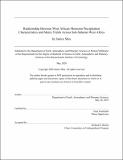Relationship Between West African monsoon precipitation characteristics and maize yields across Sub-Saharan West Africa
Author(s)
Shiu, Janice.
Download1191839088-MIT.pdf (4.023Mb)
Other Contributors
Massachusetts Institute of Technology. Department of Earth, Atmospheric, and Planetary Sciences.
Advisor
Dara Entekhabi.
Terms of use
Metadata
Show full item recordAbstract
Sub-Saharan Africa faces significant challenges to its food security in the coming decades as climate change and rapid population growth strains its agricultural systems. In a region where crops are near exclusively rainfed, precipitation from the West African Monsoon (WAM) plays a significant role in the region's food production. This study aims to add to the limited literature on the relationship between country-level maize yields and the WAM, particularly through the use of high resolution precipitation estimates to characterize the spatiotemporal variability of the monsoon. Multi-year annual precipitation characteristics of the monsoon such as total precipitation, number of non-precipitating days, and timing were derived and aggregated across the maize growing regions of West African countries. Aggregated precipitation metrics were linearly regressed against country-level maize yields that have undergone timeseries analysis to remove trends occurring independently of the WAM. The metrics most correlated with maize yields while maintaining statistically significant slopes were the minimum of total precipitation, standard deviation of the number of non-precipitating days, and the minimum monsoon end date. The strong positive correlations of the minimum of total precipitation and minimum monsoon end date metrics suggest that the worst performing areas in terms of total precipitation and monsoon end date drive down annual country-level maize yields. The positive correlation found using the standard deviation of the number of non-precipitating days is uninterpretable as an instance of Simpson's paradox, as the opposite relationship is discovered in analyses using individual countries. These results show the efficacy of analyzing maize yields against satellite mapped precipitation characteristics of the WAM.
Description
Thesis: S.B., Massachusetts Institute of Technology, Department of Earth, Atmospheric, and Planetary Sciences, May, 2020 Cataloged from the official PDF of thesis. Includes bibliographical references (pages 27-32).
Date issued
2020Department
Massachusetts Institute of Technology. Department of Earth, Atmospheric, and Planetary SciencesPublisher
Massachusetts Institute of Technology
Keywords
Earth, Atmospheric, and Planetary Sciences.